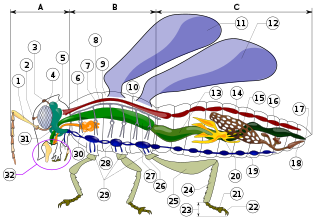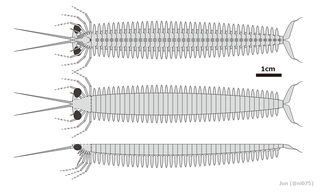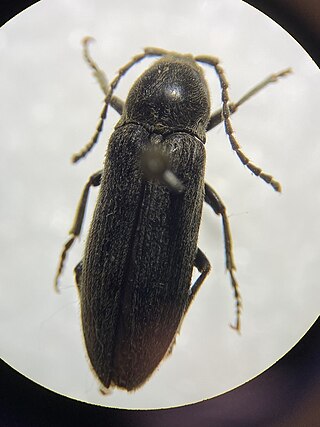
Skania is a Cambrian fossil arthropod. The type species, S. fragillis, is known from the Burgess Shale of British Columbia, Canada. A second possible species "S." sundbergi is known from the Kaili Formation of China, but its placement within the genus has been questioned.

Insect morphology is the study and description of the physical form of insects. The terminology used to describe insects is similar to that used for other arthropods due to their shared evolutionary history. Three physical features separate insects from other arthropods: they have a body divided into three regions, three pairs of legs, and mouthparts located outside of the head capsule. This position of the mouthparts divides them from their closest relatives, the non-insect hexapods, which include Protura, Diplura, and Collembola.
This glossary describes the terms used in formal descriptions of spiders; where applicable these terms are used in describing other arachnids.

Cebrionini is a tribe of click beetles from the family Elateridae; formerly ranked as a subfamily or family, they are now considered a tribe within the subfamily Elaterinae.

Wingertshellicus is an extinct genus of arthropod that has been found in Hunsrück Slate, that is located in the Rhenish Massif in Germany, and lived about 405 million years ago, during the Lower Emsian.
Microbrachius is an extinct genus of tiny, advanced antiarch placoderms closely related to the bothriolepids. Specimens range in age from the Lower Devonian Late Emsian Stage to the Middle Devonian Upper Givetian Stage. They are characterized by having large heads with short thoracic armor of an average length of 2–4 cm. There are patterns of small, but noticeable tubercles on the armor, with the arrangement varying from species to species. Specimens of Microbrachius have been found in Scotland, Belarus, Estonia, and China.

Pyrgotis plinthoglypta is a species of moth of the family Tortricidae. It is endemic to New Zealand and is found throughout the whole country. The preferred habitat of this species is native forest. The larvae of this species feeds on rimu leaves from under a silken web. It pupates in loose cocoons amongst rimu foliage. Adults are on the wing from October to May and are night flying. They are attracted to light and can be collected by beating their host tree. The adult insect resembles a small dried fragment of rimu foliage when at rest.

Ligia platycephala is a species of isopod from the genus Ligia.

Perothops is a genus of false click beetles in the family Eucnemidae containing 3 species. They are known as beech-tree beetles or perothopid beetles. They are small as they are only 10–18 millimeters long. It is the only genus in the monotypic subfamily Perothopinae. They are dark-colored beetles that are found across the United States, generally in forests. The genus was discovered by Johann Friedrich von Eschscholtz in 1836. It used to be considered a family not part of Eucnemidae. The genus's name is from Greek, translating to "maimed/crippled eye" or "eye of little necklaces/bands", referring to the placement of perothopid eyes.

Oeconesus lobatus is a species of caddisfly belonging to the family Hydrobiosidae. The species was first described by Keith Arthur John Wise in 1958, and is endemic to New Zealand.

Pseudoeconesus bistirpis is a species of caddisfly belonging to the family Hydrobiosidae. The species was first described by Keith Arthur John Wise in 1958, and is endemic to New Zealand.

Olinga fumosa is a species of caddisfly belonging to the family Conoesucidae. The species was first described by Keith Arthur John Wise in 1958, and is endemic to New Zealand.
Polyplectropus impluvii is a species of caddisfly belonging to the family Polycentropodidae. The species was first described by Keith Arthur John Wise in 1962, and is endemic to New Zealand.
Polyplectropus waitakerensis is a species of caddisfly belonging to the family Polycentropodidae. The species was first described by Keith Arthur John Wise in 1962, and is endemic to New Zealand.
Orthopsyche thomasi is a species of caddisfly belonging to the family Hydropsychidae. The species was first described by Keith Arthur John Wise in 1962, and is endemic to New Zealand.

Costachorema notopterum is a species of caddisfly belonging to the family Hydrobiosidae. The species was first described by Keith Arthur John Wise in 1972, and is endemic to the Auckland Islands of New Zealand.
Tiphobiosis kuscheli is a species of caddisfly belonging to the family Hydrobiosidae. The species was first described by Keith Arthur John Wise in 1972, and is endemic to the Auckland Islands of New Zealand.

Psilochorema embersoni is a species of caddisfly belonging to the family Hydrobiosidae. The species was first described by Keith Arthur John Wise in 1982, and is endemic to New Zealand.
Apatochernes turbotti is a species of pseudoscorpion in the family Chernetidae. The species was first described by Max Beier in 1969, and is endemic to New Zealand.

Mimopeus turbotti is a species of darkling beetle belonging to the family Tenebrionidae. The species was first described by John Charles Watt in 1988, and is endemic to Manawatāwhi / Three Kings Islands in New Zealand.














